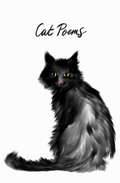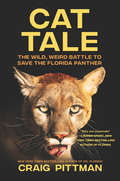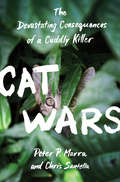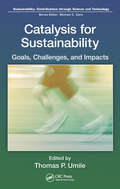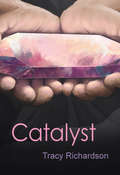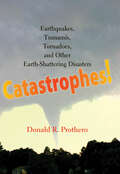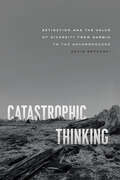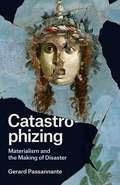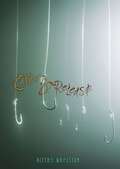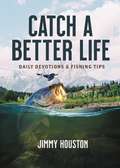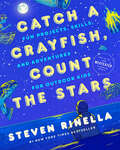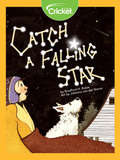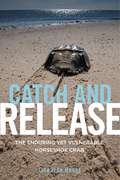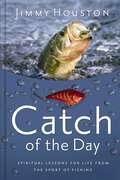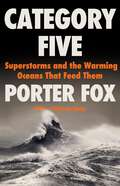- Table View
- List View
Cat Poems
by New Directions Tynan KoganeA gorgeous gift edition, dedicated to the mystery, grace, and charm of the cat Across the ages, cats have provided their adopted humans with companionship, affection, mystery, and innumerable metaphors; cats cast a mirror on their beholders; cats endlessly captivate and hypnotize, frustrate and delight. And to poets, in particular, these enigmatic creatures are the most delightful and beguiling of muses (Charles Baudelaire: “the sole source of amusement in one’s lodgings”) as they go about purring, prowling, hunting, playing, meowing, and napping, often oblivious to their so-called masters (Jorge Luis Borges: “you live in other time, lord of your realm—a world as closed and separate as a dream”). Cat Poems offers a litter of odes to our beloved felines by Charles Baudelaire, Stevie Smith, Christopher Smart, Denise Levertov, Lawrence Ferlinghetti, Rainer Maria Rilke, Muriel Spark, William Carlos Williams, Ezra Pound, and many others.
Cat Tale: The Wild, Weird Battle to Save the Florida Panther
by Craig PittmanIt wasn’t so long ago when a lot of people thought the Florida panther was extinct. They were very nearly right. That the panther still exists at all is a miracle—the result of a desperate experiment that led to the most remarkable comeback in the history of the Endangered Species Act. And no one has told the whole story—until now. <P><P>With novelistic detail and an eye for the absurd, Craig Pittman recounts the extraordinary story of the people who brought the panther back from the brink of extinction, the ones who nearly pushed the species over the edge, and the cats that were caught in the middle. This being Florida, there’s more than a little weirdness, too. <P><P>An engrossing narrative of wry humor, sharp writing and exhaustive reportage, Cat Tale shows what it takes to bring one species back and what unexpected costs such a decision brings.
Cat Wars: The Devastating Consequences of a Cuddly Killer
by Peter P. Marra Chris SantellaIn 1894, a lighthouse keeper named David Lyall arrived on Stephens Island off New Zealand with a cat named Tibbles. In just over a year, the Stephens Island Wren, a rare bird endemic to the island, was rendered extinct. Mounting scientific evidence confirms what many conservationists have suspected for some time--that in the United States alone, free-ranging cats are killing birds and other animals by the billions. Equally alarming are the little-known but potentially devastating public health consequences of rabies and parasitic Toxoplasma passing from cats to humans at rising rates. Cat Wars tells the story of the threats free-ranging cats pose to biodiversity and public health throughout the world, and sheds new light on the controversies surrounding the management of the explosion of these cat populations.This compelling book traces the historical and cultural ties between humans and cats from early domestication to the current boom in pet ownership, along the way accessibly explaining the science of extinction, population modeling, and feline diseases. It charts the developments that have led to our present impasse--from Stan Temple's breakthrough studies on cat predation in Wisconsin to cat-eradication programs underway in Australia today. It describes how a small but vocal minority of cat advocates has campaigned successfully for no action in much the same way that special interest groups have stymied attempts to curtail smoking and climate change.Cat Wars paints a revealing picture of a complex global problem--and proposes solutions that foresee a time when wildlife and humans are no longer vulnerable to the impacts of free-ranging cats.
Catalysis for Sustainability: Goals, Challenges, and Impacts (ISSN)
by Thomas P. UmileCatalysis for Sustainability: Goals, Challenges, and Impacts explores the intersection between catalytic science and sustainable technologies as a means to addressing current economic, social, and environmental problems. These problems include harnessing alternative energy sources, pollution prevention and remediation, and the manufacturing of comm
Catalyst
by Sarah Beth DurstZoe must figure out how to keep a giant kitten safe in this magical adventure about change, expectation, and accepting all for who they truly are—regardless of shape or size.Zoe named the kitten Pipsqueak, because she was so tiny, and promised to always take care of her. Then the kitten grew. And grew. Now she&’s bigger than a horse—and talking as well! Fleeing into the woods to escape the curious eyes of the Internet, Zoe and her best friend, Harrison, must keep the giant cat hidden as they desperately search for a way to return her to normal size. If they don&’t succeed, Pipsqueak may never be safe again. But why did she grow so large in the first place? And what if trying to change her back leads to even greater danger?
Catalyst (Catalysts #2)
by Tracy RichardsonFor one gifted girl, a summer helping at her mother’s archaeological dig leads to ghosts and a quest to save the planet from destruction.Marcie Horton has a sixth sense. Not in the “I see dead people” way, but . . . well, maybe a little. She feels a sort of knowing about certain things that can’t be explained—an intuition that goes beyond the normal. Then there was that one summer four years ago, when she connected with a long-departed spirit . . . . But nothing that incredible has happened to Marcie since.This summer, Marcie is spending time working at Angel Mounds, the archeological dig her mother heads, along with her brother, Eric, and his girlfriend, Renee. The site was home to an ancient indigenous civilization, and things immediately shift into the paranormal when Marcie and her dig teammates meet Lorraine and Zeke. The two mysterious dig assistants reveal their abilities to access the Universal Energy Field with their minds—something Marcie knows only vaguely that her brother has also had experience with.Marcie learns how our planet will disintegrate if action is not taken, and she and her team must decide if they are brave enough to help Lorraine and Zeke in their plan to save Mother Earth, her resources, and her history.It looks like the summer just got a lot more interesting . . . Praise for Catalyst“Tracy Richardson has created an intriguing premise that blends the worlds of sci-fi, spiritualism, and climate activism.” —Allen Johnson, screenwriter, The Freemason“An ode to the responsibility of taking care of our one and only Earth, Catalyst offers an energetic and immersive experience that spotlights alternate dimensions, energy fields, and our very own human potential.” —Genese Davis, game writer, author of The Holder’s Dominion series
Catastrophes!: Earthquakes, Tsunamis, Tornadoes, and Other Earth-Shattering Disasters
by Donald R. ProtheroDevastating natural disasters have profoundly shaped human history, leaving us with a respect for the mighty power of the earth—and a humbling view of our future. Paleontologist and geologist Donald R. Prothero tells the harrowing human stories behind these catastrophic events.Prothero describes in gripping detail some of the most important natural disasters in history:• the New Madrid, Missouri, earthquakes of 1811–1812 that caused church bells to ring in Boston• the 2004 Indian Ocean tsunami that killed more than 230,000 people• the massive volcanic eruptions of Krakatau, Mount Tambora, Mount Vesuvius, Mount St. Helens, and Nevado del RuizHis clear and straightforward explanations of the forces that caused these disasters accompany gut-wrenching accounts of terrifying human experiences and a staggering loss of human life. Floods that wash out whole regions, earthquakes that level a single country, hurricanes that destroy everything in their path—all are here to remind us of how little control we have over the natural world. Dramatic photographs and eyewitness accounts recall the devastation wrought by these events, and the people—both heroes and fools—that are caught up in the earth's relentless forces. Eerie, fascinating, and often moving, these tales of geologic history and human fortitude and folly will stay with you long after you put the book down.
Catastrophes, Confrontations, and Constraints: How Disasters Shape the Dynamics of Armed Conflicts
by Tobias IdeA ground-breaking study on how natural disasters can escalate or defuse wars, insurgencies, and other strife.Armed conflict and natural disasters have plagued the twenty-first century. Not since the end of World War II has the number of armed conflicts been higher. At the same time, natural disasters have increased in frequency and intensity over the past two decades, their impacts worsened by climate change, urbanization, and persistent social and economic inequalities. Providing the first comprehensive analysis of the interplay between natural disasters and armed conflict, Catastrophes, Confrontations, and Constraints explores the extent to which disasters facilitate the escalation or abatement of armed conflicts—as well as the ways and contexts in which combatants exploit these catastrophes.Tobias Ide utilizes both qualitative insights and quantitative data to explain the link between disasters and the (de-)escalation of armed conflict and presents over thirty case studies of earthquakes, droughts, floods, and storms in Africa, the Middle East, Asia, and Latin America. He also examines the impact of COVID-19 on armed conflicts in Iraq, Afghanistan, Nigeria, and the Philippines.Catastrophes, Confrontations, and Constraints is an invaluable addition to current debates on climate change, environmental stress, and security. Professionals and students will greatly appreciate the wealth of timely data it provides for their own investigations.
Catastrophic Events Student Guide and Source Book (2nd Edition)
by Carol O’donnellThis edition of student guide and source book on Catastrophic Events contains three parts viz., Storms, Earthquakes and Volcanoes. Also included are Glossary, Index, Photo Credits and Selected References.
Catastrophic Thinking: Extinction and the Value of Diversity from Darwin to the Anthropocene (science.culture)
by David SepkoskiA history of scientific ideas about extinction that explains why we learned to value diversity as a precious resource at the same time as we learned to “think catastrophically” about extinction. We live in an age in which we are repeatedly reminded—by scientists, by the media, by popular culture—of the looming threat of mass extinction. We’re told that human activity is currently producing a sixth mass extinction, perhaps of even greater magnitude than the five previous geological catastrophes that drastically altered life on Earth. Indeed, there is a very real concern that the human species may itself be poised to go the way of the dinosaurs, victims of the most recent mass extinction some 65 million years ago. How we interpret the causes and consequences of extinction and their ensuing moral imperatives is deeply embedded in the cultural values of any given historical moment. And, as David Sepkoski reveals, the history of scientific ideas about extinction over the past two hundred years—as both a past and a current process—is implicated in major changes in the way Western society has approached biological and cultural diversity. It seems self-evident to most of us that diverse ecosystems and societies are intrinsically valuable, but the current fascination with diversity is a relatively recent phenomenon. In fact, the way we value diversity depends crucially on our sense that it is precarious—that it is something actively threatened, and that its loss could have profound consequences. In Catastrophic Thinking, Sepkoski uncovers how and why we learned to value diversity as a precious resource at the same time as we learned to think catastrophically about extinction.
Catastrophizing: Materialism and the Making of Disaster
by Gerard Passannante“Few books could be more relevant . . . Passannante examines the human inclination to imagine sudden, all-consuming destruction.” —Rebecca Totaro, The Spenser ReviewWhen we catastrophize, we think the worst. We make too much of too little, or something of nothing. Yet what looks simply like a bad habit, Gerard Passannante argues, was also a spur to some of the daring conceptual innovations and feats of imagination that defined the intellectual and cultural history of the early modern period.Reaching back to the time between the Renaissance and the Enlightenment, Passannante traces a history of catastrophizing through literary and philosophical encounters with materialism—the view that the world is composed of nothing but matter. As artists, poets, philosophers, and scholars pondered the physical causes and material stuff of the cosmos, they conjured up disasters out of thin air and responded as though to events that were befalling them. From Leonardo da Vinci’s imaginative experiments with nature’s destructive forces to the fevered fantasies of doomsday astrologers, from the self-fulfilling prophecies of Shakespeare’s tragic characters to the mental earthquakes that guided Kant toward his theory of the sublime, Passannante shows how and why the early moderns reached for disaster when they ventured beyond the limits of the sensible. He goes on to explore both the danger and the critical potential of thinking catastrophically in our own time.“Brings together literature, visual art, and the history of science to provide rich insights into catastrophic thinking and the history of materialist thought.” ―The British Society for Literature and Science (award citation)
Catch & Release (Carolrhoda Ya Ser.)
by Blythe WoolstonI should have died quick. But I didn't. I'm a miracle of modern medicine, only the medicine doesn't get much credit, I notice. People say I'm lucky, or I'm blessed, and then they turn away. I'm not the only miracle. There's Odd too. Polly Furnas had The Plan for the future. Get married to Bridger Morgan, for one. College, career, babies. Etc. All the important choices were made. It was all happily-ever-after as a diamond-ring commercial. But The Plan did not include a lethal drug-resistant infection. It did not include “some more reconstruction and scar revision in the future." And it certainly did not include Odd Estes, a trip to Portland in an ancient Cadillac to "tear Bridger a new one," fly fishing, marshmallows, Crisco, or a loaded gun. But plans change. Stories get revised and new choices must be made. Polly and Odd have choices. Surviving or not. Catch or release.
Catch a Better Life: (A 365-Day Devotional) – Perfect Christian Men and Women Who Love to Fish
by Jimmy HoustonBass fishing pro Jimmy Houston gives outdoor enthusiasts from beginners to bassmasters spiritual insights and fishing tips in this yearlong devotional.What does a fishing lure have to do with following Jesus? How can casting our lines remind us of our commitment to godly living? In what ways does the underwater world teach us about God's purposes? In Catch a Better Life, hugely popular pro fisherman Jimmy Houston shares wisdom from the Bible along with plenty of savvy fishing advice. Each entry in this 365-day devotional includes:A Scripture verse from the Old or New TestamentA brief meditation that applies insights from the art of fishing to spiritual growthA pro fishing tip With its colorful photos and a presentation page, this full-color book makes a perfect gift for:The outdoor enthusiastAnyone who loves to fish or wants to learnFollowers of Jimmy Houston as TV host and fisher extraordinaireRetirement parties, Father's Day, Grandparents' Day, birthdays, Christmas If you love God's creation--along with the excitement of the catch--and want to grow in your spiritual life, reel in this fisherman's devotional guide to following God with purpose.
Catch a Crayfish, Count the Stars: Fun Projects, Skills, and Adventures for Outdoor Kids
by Steven RinellaA hands-on, gloves-off, muddy-boots activity book for young adventurers ages eight and up, offering fun projects and adventures to build lifelong skills and knowledge about the natural world—from the host of MeatEater and the New York Times bestselling author of The MeatEater Guide to Wilderness Skills and Survival <p><p> Does climbing a tree, building a bug hotel, spearing a bullfrog, stalking wild animals, and scouting for petrified wood sound more fun than homework or chores? If so, this guide is your perfect companion to endless summer days and rainy fall afternoons alike. Filled with advice, insights, and activities to inspire wonder and excitement about the natural world, Catch a Crayfish, Count the Stars is a curious kid’s treasure trove, filled to the brim with outdoor projects, skills, and adventures complete with illustrations. The book presents a ton of fun and exciting ways to explore the natural world, like <p>• building an outdoor exploration kit <p>• identifying constellations and navigating using the sun and stars <p>• collecting fossils and other geological wonders <p>• tracking animals and following weather patterns <p>• making your own compass <p>• growing your own fruits and vegetables <p>• building survival shelters and primitive hunting weapons <p>• fishing, hunting, and foraging for wild foods <p>• making cool art projects using natural materials <p><p> A must-have guide for budding naturalists, scientists, gardeners, anglers, foragers, and hunters, Catch a Crayfish, Count the Stars helps get kids out into nature, imparting lifelong knowledge and skills along the way. <p> <b>New York Times Bestseller</b>
Catch a Falling Star
by Bradford H. RobieAnna must wake up late and struggle to keep warm outside so she can watch a meteor shower.
Catch and Release: The Enduring Yet Vulnerable Horseshoe Crab
by Lisa Jean MooreThe unexpected and fascinating interspecies relationship between humans and horseshoe crabs.Horseshoe crabs are considered both a prehistoric and indicator species. They have not changed in tens of millions of years and provide useful data to scientists who monitor the health of the environment. From the pharmaceutical industry to paleontologists to the fishing industry, the horseshoe crab has made vast, but largely unknown, contributions to human life and our shared ecosystem. Catch and Release examines how these intersections steer the trajectory of both species’ lives, and futures. Based on interviews with conservationists, field biologists, ecologists, and paleontologists over three years of fieldwork on urban beaches, noted ethnographer Lisa Jean Moore shows how humans literally harvest the life out of the horseshoe crabs. We use them as markers for understanding geologic time, collect them for agricultural fertilizer, and eat them as delicacies, capture them as bait, then rescue them for conservation, and categorize them as endangered. The book details the biomedical bleeding of crabs; how they are caught, drained of 40% of their blood, and then released back into their habitat. The model of catch and release is essential. Horseshoe crabs cannot be bred in captivity and can only survive in their own ecosystems. Moore shows how horseshoe crabs are used as an exploitable resource, and are now considered a “vulnerable” species.An investigation of how humans approach animals that are essential for their survival, Catch and Release questions whether humans should have divine, moral, or ethical claims to any living being in their path.
Catch of the Day: Spiritual Lessons for Life from the Sport of Fishing (A 365-Day Devotional) – Perfect Christian Men and Women Who Love to Fish
by Jimmy HoustonFishermen don&’t rely on luck in order to catch fish—they put their skills, knowledge, and experience into play every time they cast their line. Likewise, righteous and godly living doesn&’t come naturally but requires study, commitment, and a lot of practice. In Catch of the Day, Jimmy Houston combines his love of fishing and his love of God in this unique fisherman&’s 365-day devotional. Each day features:A meaningful ScriptureA daily devotional that incorporates a thought for meditation which applies insights from the art of fishing to daily spiritual growthA fishing tip from bassmaster, Jimmy Houston With colorful interiors and a ribbon marker, Catch of the Day is a great gift for:Birthdays, Father&’s Day, and ChristmasGrandparents Day or as an encouragement boost for an outdoors enthusiast needing a lift Put into action the characteristics needed to be a great fisherman, and see how they can also make you into a great fisher of men. Anyone who loves God&’s creation, combined with the excitement of the catch, will truly enjoy this yearlong guide of spiritual lessons for life.
Catch the Wind, Harness the Sun: 22 Super-Charged Projects for Kids
by Michael J. CadutoGet charged up about energy! With more than 20 fun activities and experiments that will have children ages 8 to 12 enthusiastically engaged with making and using renewable energy, Michael J. Caduto takes a hands-on approach to fighting climate change. Step-by-step instructions for projects range from using the sun to make fires to charging electronic devices by peddling your bicycle. Additional energy case studies encourage kids to think about the basic tenets of resource management. Change the world — one miniature windmill at a time.
Catching Fog // Making Rain (Fountas & Pinnell LLI Purple #Level S)
by Sarah BrockettProvides information about increasing water supply.
Catching Nature in the Act: Réaumur and the Practice of Natural History in the Eighteenth Century
by Mary TerrallNatural history in the eighteenth century was many things to many people--diversion, obsession, medically or economically useful knowledge, spectacle, evidence for God’s providence and wisdom, or even the foundation of all natural knowledge. Because natural history was pursued by such a variety of people around the globe, with practitioners sharing neither methods nor training, it has been characterized as a science of straightforward description, devoted to amassing observations as the raw material for classification and thus fundamentally distinct from experimental physical science. In Catching Nature in the Act, Mary Terrall revises this picture, revealing how eighteenth-century natural historians incorporated various experimental techniques and strategies into their practice. At the center of Terrall’s study is René-Antoine Ferchault de Réaumur (1683-1757)--the definitive authority on natural history in the middle decades of the eighteenth century--and his many correspondents, assistants, and collaborators. Through a close examination of Réaumur’s publications, papers, and letters, Terrall reconstructs the working relationships among these naturalists and shows how observing, collecting, and experimenting fit into their daily lives. Essential reading for historians of science and early modern Europe, Catching Nature in the Act defines and excavates a dynamic field of francophone natural history that has been inadequately mined and understood to date.
Catching Spring (Orca Young Readers)
by Sylvia OlsenThe year is 1957, and Bobby lives on the Tsartlip First Nation reserve on Vancouver Island where his family has lived for generations and generations. Bobby loves his weekend job at the nearby marina. He loves to play marbles with his friends. And he loves being able to give half his weekly earnings to his mother to eke out the grocery money, but he longs to enter the up-coming fishing derby. With the help of his uncle and Dan from the marina his wish just might come true.
Catching Yellowstone's Wild Trout: A Fly-Fishing History and Guide (Natural History)
by Chris HuntThis history and guide to the fly-fishing waters of Yellowstone National Park is a loving homage to the region&’s iconic wild trout. Yellowstone National Park is home to some of the most storied destinations in the history of fly fishing. Casting in the Firehole River is like going back in time to when bison roamed nearly every meadow in the West. Restored to their natal streams after near extinction, native Arctic grayling can once again be plucked from icy water at the foot of breathtaking waterfalls. Meanwhile, a daylong hike into true wild country rewards an angler with a chance to catch trophy native cutthroat trout on a lonely mountain lake. In Catching Yellowstone&’s Wild Trout, local journalist and experienced angler Chris Hunt explores the rich history of these beloved and bountiful waters.</
Category Five: Superstorms and the Warming Oceans That Feed Them
by Porter FoxSuperstorms, hurricanes, typhoons, and spiraling freak weather: the fallout of global warming is a real-life natural thriller, as captured in Porter Fox&’s urgent and stunning story of chasing the world&’s most devastating storms. Here is the story of the largest storms on earth and how those storms are growing bigger and stronger. The tale of extreme weather doesn&’t begin with floods, fires, or even the air that carries this change to our lives. It begins with the ocean. Oceans create weather, climate, floods, droughts, and most of the geophysical fallout of global warming. Exactly how, award-winning writer Porter Fox contends, depends on invisible ocean currents, planetary cycles just now being defined, and processes in the deep ocean that may well have already saved us from the worst effects of the climate crisis. In an attempt to avert a coming age of superstorms, sea level rise, and catastrophic warming, scientists followed the lead of a college drop-out-turned-maverick sailor and storm-chaser; a Romanian refugee turned BBC radio host turned circumnavigating mapmaker; and an audacious new attempt to study storms above as well as deep below the ocean depths, using drones. Throughout Category Five, Fox shadows these explorers, scientists, oceanographers, and weather forecasters in an attempt to understand, forestall, and possibly harness the awesome power of our oceans.
Caterpillars in the Middle: Tritrophic Interactions in a Changing World (Fascinating Life Sciences)
by Robert J. Marquis Suzanne KopturCaterpillars are excellent model organisms for understanding how multiple selective forces shape the ecology and evolution of insects, and organisms in general. Recent research using the tools of modern molecular biology, genetics, metabolomics, microbial ecology, experiments conducted at a global level, network analysis, and statistical analyses of global data sets, combined with basic natural history, are yielding exciting new insights into caterpillar adaptations and ecology. The best way to view these research advances is within a framework of tri-trophic interactions. This is a timely topic for research given the central role of caterpillars and plants in the ecology and trophic structure of terrestrial communities. This book is unique in that it contains chapters from a team of experts on a diversity of key topics within caterpillar-plant interactions. This volume brings together contributions by researchers from around the globe, working in both tropical and temperate habitats, and in human-managed and more natural habitats. It is a significant contribution to our understanding of insect biology, and the role that insects, as represented by caterpillars, play in a world increasingly dominated by humans and one in which threats to insect biodiversity are mounting.Chapter 11 is available open access under a Creative Commons Attribution 4.0 International License via link.springer.com.
